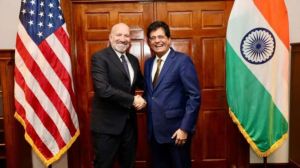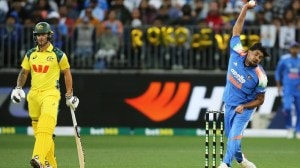Suddenly, one summer
As the monsoon takes shape in that great laboratory of the Indian Ocean, this is as good a time as any to look at a summer when the domina...

As the monsoon takes shape in that great laboratory of the Indian Ocean, this is as good a time as any to look at a summer when the dominant image was that of empty pitchers and parched earth. It has even been argued, after careful consideration of the rainfall readings of the last decade, that there was no drought, that it was the “artificial creation” of journalists and politicians. What was experienced was really a water shortage, or so the argument went. Rajasthan’s chief minister, Ashok Gehlot, roundly berated the media for exaggerating the situation. His state, he pointed out with some justification, had experienced water shortage for hundreds of years.
So did the mirror distort? Were those images of women being lowered into 200-feet wells, of farmers looking with despair upon farmlands that resembled moonscapes, of four-year-olds standing for hours in long queues to procure a bucket of water, just selected snapshots of an extremely complex social and ecological reality? Of course they were. But then all media coverage, given its eclectic and momentary nature, is selective and often arbitrarily and illogically so. Otherwise, why would the stock markets, which directly impinge upon the lives of just a minuscule percentage of the country’s population, have come to occupy such inordinate importance in terms of media coverage?
For all its undoubted inadequacies, however, the media is the only major collective source of information and images that a democracy has. It helps to create a “public sphere”, as Edward S. Herman and Roberty W. McChesney argue in their book, The Global Media, “where issues of importance to a political community are discussed and debated and where information is presented that is essential to citizen participation in community life”.
Throughout history, the media at its best has done just that. For instance, this was how Elihu Burritt had seen the “Great Hunger”, as the Irish potato famine was termed: “We entered a stinted den by an aperture three feet high, and found one or two children lying asleep with their eyes open in the straw. Such, at least, was their appearance, for they scarcely winked while we were before them. The father came in and told his pitiful story of want, saying that not a morsel of food had they tasted for 24 hours.” In time, this calamity which in the mid-19th century led to the death of one million and the migration of 1.5 million, captured international attention and led to detailed studies of its causes and consequences. But it is to foot soldiers like Burritt that the credit for raising public consciousness on an unacceptable reality must go.
In his studies on famine, Amartya Sen has of course constantly underscored the causal connection between democracy and the non-occurrence of famines. He sees the informational link as crucial to this process. As he points out, the world and, ironically enough, even the Chinese leadership of that era, were largely in the dark about the massive famines that occurred in that country between 1958-61 the period of the Great Leap Forward.
It killed 30 million but nobody was any the wiser because there was no political opposition and no pressure from the newspapers, since they were all government-owned. Information on famines embarrasses the ruling elites and forces them to act. Writes Sen: “A free press and the practice of democracy contribute greatly to bringing out information that can have an enormous impact on policies for famine prevention… Indeed I would argue that a free press and an active opposition constitute the best early warning system a country threatened by famines can have.”
Let us say, for reasons of argument, that the Great Thirst of AD 2000 India was really only localised water shortages created by discrete causes in varied pockets of the country. It can still be argued nevertheless that given the scale of the phenomenon, media coverage of it was not just necessary but essential. For at least two reasons.
First, perhaps never before in the history of the Indian media was the divide between the metropolitan and the subaltern, the powerful and the powerless, obliterated so consistently and for such a length of time. The Indian media is notorious for its obsession with politics and it is politics defined in the most narrow sense of the term. Several years ago, media analyst Bhaskar Rao made an observation that still holds good today, even though the media scene has undergone a radical transformation.
He pointed out that some 50-60 journalists located within a radius of a few kilometres from Parliament House, New Delhi, determined the news priorities and half the news content of the nation. What’s more, 90 per cent of newspapers are published from 25 metros. Television’s record is much worse.
Where you are located informs what you know and what you report. It was this karmic truth that was stood on its head this summer. For a brief moment, Jodhabai actually made it to the front page. Young city slickers in their Reeboks and Benetton teeshirts actually disdained government handouts and trundled with their notepads and cameras behind Jodhabai, ate her frugal repast, reported on her migrant husband and sick children.
And it was not just Jodhabai that got her place in the media sun but her matka of water too. In this mad, miraculous summer, just as Jodhabai on occasion became more important than the Prime Minister, the water pool deficit pipped the oil pool deficit to the headlines. Suddenly terms that only agricultural scientists and environmentalists had bandied around words like aquifers, water harvesting, drought-resistant crops were on everybody’s lips. Water conservation was seen as a desirable goal, as important, in fact, as defending the country’s borders the theme of the media’s exertions last May.
Sure, there was a great deal that was wrong with the coverage. Real people were constantly rendered as faceless victims. Tedious repetition of the issue often led to reader/listener fatigue. Sensationalism sometimes marked the narrative. All too often, the drought became an event, and the numerous social factors that created it went unreported. Besides, it would be naive in the extreme to say that the media has finally discovered a conscience.
Noted editor Harold Evans, commenting in a volume that looked at journalism in the 20th century, remarked that investigative journalism, through its vivid images of 10-year-olds working in coal mines for 35 cents a day, actually accelerated the battle to totally root out child labour in the US of the early 20th century. Would it be too much to hope then that the summer of 2000, and the media coverage of it, has taught us some valuable lessons about the use and abuse of water resources, a substance that by its very nature demands equality of access.





- 01
- 02
- 03
- 04
- 05


























